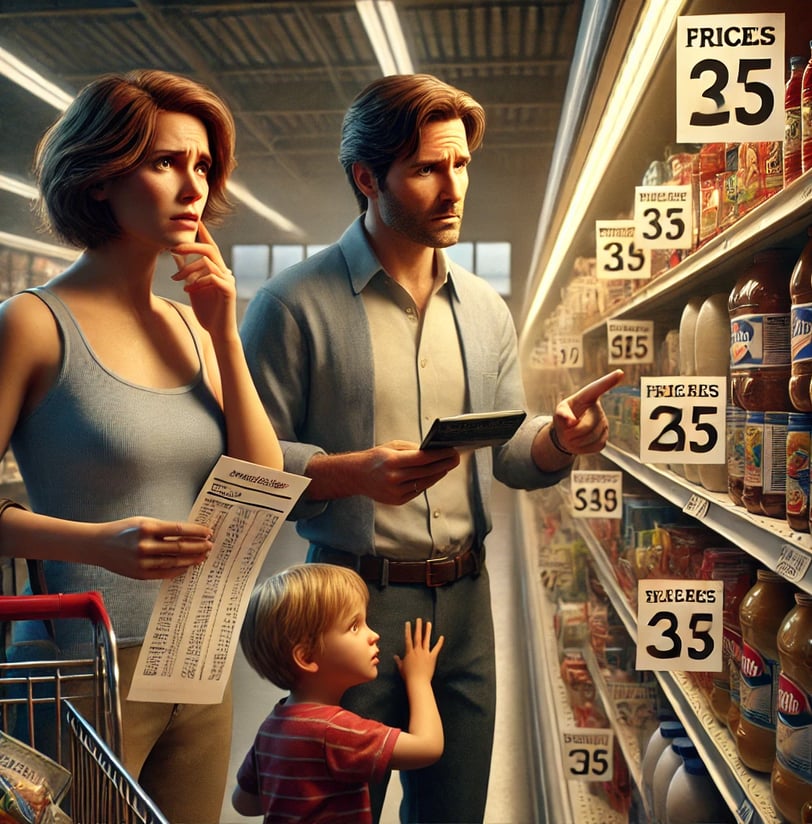Rising Prices Impact Consumer Confidence in the U.S.
Rising Prices: Over the past two years, consumers in the United States have faced persistent price increases on essential goods and services. This surge in costs has led to a decline in consumer confidence, as reflected in economic indicators and shifting . As inflation continues to affect household budgets, concerns over economic stability and future purchasing power aremounting.
2/27/20252 min read


Decline in Consumer Confidence
The Consumer Confidence Index, measured by The Conference Board, dropped significantly in early 2025, falling 7 points to 98.3 in February. This decline marks the sharpest decrease since mid-2021, reflecting growing pessimism among American consumers. Analysts had projected a smaller decline, highlighting that the drop exceeded expectations. Lower confidence typically translates to reduced discretionary spending, further impacting economic growth.
Key Factors Driving Higher Prices
Several factors have contributed to rising costs and the subsequent drop in consumer confidence:
1. Persistent Inflation
Despite efforts by the Federal Reserve to curb inflation through interest rate hikes, prices on everyday essentials remain high. Some of the most affected categories include:
Groceries: The cost of basic food items has surged. In early 2025, the average price of a dozen eggs is around $4.50, up from $1.60 in 2020. A gallon of milk now averages $4.20, compared to $2.90 a few years ago.
Gasoline: Fuel prices remain volatile, with the national average per gallon fluctuating between $3.80 and $4.50, significantly impacting transportation costs.
Housing: Rental prices have seen a sharp increase, with the median rent for a one-bedroom apartment reaching $1,850 per month, up from $1,500 in 2021. Mortgage rates hovering around 7% have also made homeownership less accessible.
2. Trade Policies and Import Tariffs
Government-imposed tariffs on imported goods have contributed to price hikes. For instance, increased tariffs on Chinese electronics and household appliances have made items like refrigerators, washing machines, and televisions more expensive. In some cases, these costs have risen by 15-25% in the past two years.
3. Supply Chain Disruptions
While global supply chains have recovered from pandemic-related disruptions, shortages of key materials and labor constraints continue to impact pricing. Semiconductor shortages, for example, have kept the cost of consumer electronics and automobiles high, with new car prices averaging $48,000 in early 2025, up from $36,000 in 2020.
4. Extreme Weather and Agricultural Impacts
Droughts, hurricanes, and other climate-related events have significantly affected food production. Reduced crop yields have driven up the price of wheat, corn, and dairy products, affecting both grocery prices and restaurant costs.
How Consumers Are Adjusting Their Spending Habits
In response to rising costs and economic uncertainty, American consumers are making significant adjustments to their spending behaviors:
Cutting Back on Non-Essentials: Many households are reducing expenditures on dining out, entertainment, and travel. The hospitality industry has reported a slowdown in bookings as discretionary spending tightens.
Opting for Budget-Friendly Alternatives: Consumers are shifting toward private-label grocery brands and discount retailers to save money. Dollar stores and wholesale club memberships have seen increased sales as people seek cost-effective shopping options.
Delaying Major Purchases: High interest rates and inflation have made big-ticket purchases like cars, home renovations, and electronics less appealing. Many consumers are holding off on such investments until economic conditions stabilize.
Future Outlook and Potential Solutions
Several factors will determine whether consumer confidence can rebound in the coming months:
Federal Reserve Policies: Continued adjustments to interest rates will impact borrowing costs and overall spending.
Government Intervention: Policies aimed at addressing food insecurity, housing affordability, and wage growth could help ease financial pressure on households.
Market Adjustments: If supply chain disruptions ease and production capacity increases, prices for goods and services may stabilize.
Conclusion
The rising cost of living has put significant pressure on American consumers, leading to declining confidence and altered spending habits. As inflation persists, households are forced to make tough financial decisions, prioritizing essentials over discretionary spending. While economic conditions remain uncertain, a combination of policy measures, market corrections, and consumer resilience will shape the path forward. Understanding and adapting to these challenges will be crucial for businesses and policymakers alike as they navigate an evolving economic landscape.
Explore
Discover diverse topics in one convenient hub.
Connect
Learn
contact@mindstormblog.com
© 2025. All rights reserved.

